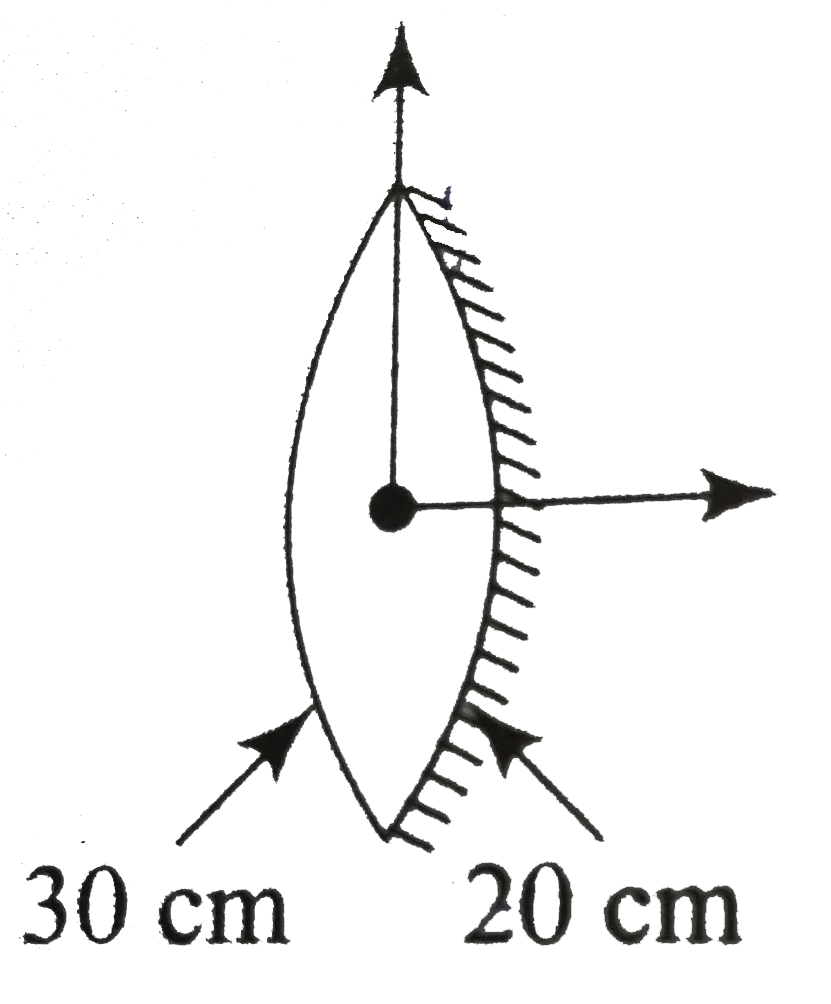A biconvex thin lens is prepared from glass of refractive index μ2=32. The two conducting surfaces have equal radii of 20 cm each. One of the the surface is silvered from outside to make it reflecting. It is placed in a medium of refractive index μ1=53. It acts as a
converging mirror
diverging mirror
concave mirror of focal length 12.5 cm
convex mirror of focal length 12.5 cm
The correct Answer is:A, C
To solve the problem step by step, we need to determine whether the given biconvex lens with one silvered surface acts as a converging or diverging mirror and calculate its focal length.
1. Identify the Given Data:
- Refractive index of the lens (glass), μ2=32
- Refractive index of the medium, μ1=53
- Radius of curvature of both surfaces, R1=R2=20cm
2. Determine the Type of Mirror:
- Since one surface of the biconvex lens is silvered, it behaves like a concave mirror. A concave mirror converges light rays, hence it acts as a converging mirror.
3. Calculate the Focal Length of the Lens:
- We will use the Lens Maker's Formula:
1FL=(μ2−μ1)(1R1−1R2)
- Substituting the values:
1FL=(32−53)(120−(−120))
4. Calculate the Difference in Refractive Indices:
- Convert 32 and 53 to a common denominator:
32=96,53=106
- Thus,
32−53=96−106=−16
5. Calculate the Curvature Terms:
- The curvature terms:
120−(−120)=120+120=220=110
6. Substitute Back into the Lens Formula:
- Now substituting back:
1FL=−16⋅110=−160
- Therefore, the focal length of the lens is:
FL=−60cm
7. Calculate the Focal Length of the Mirror:
- The focal length of the concave mirror formed by the silvered surface is half the radius of curvature:
FM=R2=202=10cm
8. Calculate the Equivalent Focal Length:
- The equivalent focal length of the system (acting as a mirror) can be calculated as:
1Fequiv=1FL+1FM
- Substituting the values:
1Fequiv=−160+110=−160+660=560=112
- Therefore, the equivalent focal length is:
Fequiv=12cm
Final Answer:
The biconvex lens with one silvered surface acts as a converging mirror and has an equivalent focal length of 12 cm.
- Refractive index of the lens (glass), μ2=32
- Refractive index of the medium, μ1=53
- Radius of curvature of both surfaces, R1=R2=20cm
- Since one surface of the biconvex lens is silvered, it behaves like a concave mirror. A concave mirror converges light rays, hence it acts as a converging mirror.
- We will use the Lens Maker's Formula:
1FL=(μ2−μ1)(1R1−1R2)
- Substituting the values:
1FL=(32−53)(120−(−120))
- Convert 32 and 53 to a common denominator:
32=96,53=106
- Thus,
32−53=96−106=−16
- The curvature terms:
120−(−120)=120+120=220=110
- Now substituting back:
1FL=−16⋅110=−160
- Therefore, the focal length of the lens is:
FL=−60cm
- The focal length of the concave mirror formed by the silvered surface is half the radius of curvature:
FM=R2=202=10cm
- The equivalent focal length of the system (acting as a mirror) can be calculated as:
1Fequiv=1FL+1FM
- Substituting the values:
1Fequiv=−160+110=−160+660=560=112
- Therefore, the equivalent focal length is:
Fequiv=12cm
The biconvex lens with one silvered surface acts as a converging mirror and has an equivalent focal length of 12 cm.
Topper's Solved these Questions
- RAY OPTICSBOOK - CENGAGE PHYSICS ENGLISHCHAPTER - RAY OPTICSEXERCISE - DPP 1.5
13 Videos
- RAY OPTICSBOOK - CENGAGE PHYSICS ENGLISHCHAPTER - RAY OPTICSEXERCISE - DPP 1.6
12 Videos
- RAY OPTICSBOOK - CENGAGE PHYSICS ENGLISHCHAPTER - RAY OPTICSEXERCISE - DPP 1.3
14 Videos
- PHOTOELECTRIC EFFECTBOOK - CENGAGE PHYSICS ENGLISHCHAPTER - PHOTOELECTRIC EFFECTEXERCISE - Integer Type
4 Videos
- SOURCES OF MAGNETIC FIELDBOOK - CENGAGE PHYSICS ENGLISHCHAPTER - SOURCES OF MAGNETIC FIELDEXERCISE - single correct Ansewer type
12 Videos
Similar Questions
A biconvex thin lens is prepared from glass of refractive index 3/2. The two bounding surfaces have equal radii of 25cm each. One of the surfaces is silvered from outside to make it reflecting. Where should an object be placed before this lens so that the image coincides with the object.
View SolutionA biconvex thin lens is prepared from glass (μ=1.5), the two bounding surfaces having equal radii of 25 cm each. One of the surfaces is silvered from outside to make it reflecting. Whee should an object be placed before this lens so that the image is formed on the object itself?

View SolutionA biconvex thin lens is prepared from glass (μ=1.5), the two bounding surfaces having equal radii of 25 cm each. One of the surfaces is silvered from outside to make it reflecting. Whee should an object be placed before this lens so that the image is formed on the object itself?

View SolutionAn equiconvex lens is made from glass of refractive index 1.5. If the radius of each surface is changed from 5cm to 6cm, then the power
View SolutionA biconvex lens is made of glass with refractive index 1.5 and has radii of curvature 20 cm and 30 cm. If the 20 cm surface is silvered, what is the effective focal length of the mirror formed?

View SolutionA biconvex lens made of glass (refractive index 1.5) has two spherical surfaces having radii 20cm and 30cm. Calculate its focal length.
View SolutionA concavo-convex lens is made of glass of refractive index 1.5. The radii of curvature of its two surfaces are 30cm and 50cm. Its focal length when placed in a liquid of refractive index 1.4 is
View SolutionA double convex lens has two surfaces of equal radii R and refractive index m=1.5, we have
View SolutionA planocovex lens is made of a material of refractive in μ=1.5 The radius of curvature of curved surface of the lens is 20.cm. If its plane surface3 is silvered, the focal length of the silvered lens will be
View SolutionA thin lens made of glass of refractive index μ=1.5 has a focal length equal to 12 cm in air. It is now immersed in water (μ=43). Its new focal length is
View Solution